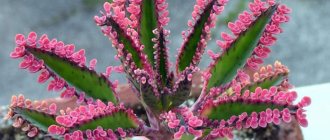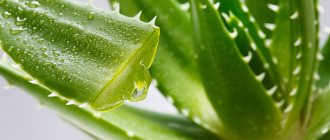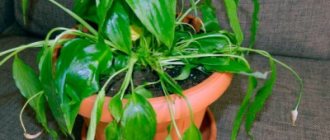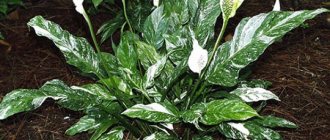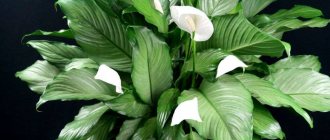Spathiphyllum (Spathiphyllum) is a herbaceous perennial from the Araceae family. Spathiphyllum is native to the tropical regions of Central and South America. Some species originate from Indonesia and the Philippine Islands.
The plant is decorative thanks to its glossy dark emerald foliage, collected in a basal rosette with a height of 30 cm to 1 m. The rhizome of the flower is shortened, the stem is absent. The leaves are oval, pointed towards the apex, with a distinct midrib. The petioles are long, widening downward.
The plant is very similar to Anthurium, read how they differ.
The inflorescence is a spadix wrapped in a delicate snow-white blanket in most species, although it can also be light green in color. After the end of flowering, which lasts 6-10 weeks, the cover turns green.
| In one season, the plant doubles in growth. |
| Blooms in summer; with high humidity it can bloom in winter |
| The plant is easy to grow indoors |
| Perennial |
Beneficial and harmful properties of spathiphyllum
The flower is known as one of the best air purifiers from various harmful chemical compounds - benzene, formaldehyde, trichlorethylene and others, as well as from acetone and alcohol vapors. According to some sources, it prevents the appearance of mold.
However, like most aroids, it contains oxalate crystals, which can cause irritation of the mucous membranes of the mouth, tongue and even swelling of the larynx if a small child suddenly decides to taste a leaf of the plant.
Signs and superstitions
Among flower growers, there is a conflicting opinion about the energy of the perennial - some believe that it drives men out of the house, others, on the contrary, are sure that it helps to find their soul mate.
It’s not for nothing that the flower is called “women’s happiness.” They say that if you grow it next to anthurium - “male happiness”, then harmony and mutual understanding will reign in the house. It’s even better to plant them in the same pot, however, many gardeners are skeptical about this sign - plants have significantly different care and maintenance conditions.
One of the most important superstitions associated with the flower indicates the attraction of love and the onset of a long-awaited pregnancy. And the expected event will happen as soon as the spathiphyllum bud blooms.
If the flower dries up, then happiness leaves the family. The plant does not tolerate scandals and quarrels indoors, and immediately drops its lifeless leaves. Whether these signs are true or not is up to each gardener to decide for himself.
Is it possible to delay the withering process, how to care for it?
You should not feed exotic plants during flowering in order to delay the wilting process. This can only cause harm - brown spots will appear on the canvas.
To ensure bright colors and complete ripening of the buds, spathiphyllum is prepared in advance, as soon as it has come to life after a winter rest. Potassium-phosphorus fertilizers are useful for prolonging flowering.
You can also preserve the freshness of flowers with cool air temperatures (20-220C). But the root system should not be overcooled; the temperature should not drop much (maximum to 150C).
Features of home care (Briefly)
| Temperature | In summer it grows at 18-27 degrees, in winter it is advisable to keep the temperature at 16-18 degrees, in case of short-term absence of watering the critical indicator is 13 degrees above zero. |
| Air humidity | At least 50% is required; spraying is required in summer. |
| Lighting | The light is dim, adapts to partial shade, and gets burned from direct sunlight. In winter, good diffused lighting is important. |
| Watering | The earth ball should be kept constantly moist. In summer, water 2-3 times, in winter – once a week. |
| Priming | The soil mixture is made up of 2 parts of turf soil and 1 part each of leaf, peat, humus soil and sand with the addition of a small amount of brick chips and charcoal. A layer of expanded clay drainage at the bottom is required. |
| Top dressing | Spathiphyllum at home is fed once a week with universal fertilizer from spring to autumn, in winter - once every 2-3 weeks. |
| Transfer | Every year in the spring with moving to a flower container of a larger diameter, mature plants - after 3-5 years. |
| Features of cultivation | Doesn't like being placed in a draft or near a gas stove. |
Fertilizer application
Proper care of spathiphyllum necessarily involves fertilizing. Without the use of additional fertilizers in the soil, the plant simply will not bloom. The crop needs nutrients not only for the formation of buds, but also for the abundant growth of green mass.
Fertilizing is applied from the beginning of spring until the onset of autumn every 2 weeks. Blooming spathiphyllum can be fertilized every 10 days. During the budding period, the plant consumes a lot of nutrients, and especially needs potassium and phosphorus.
In autumn and winter, women's happiness does not need feeding only if it does not bloom.
Fertilizers must be applied to wet soil, no earlier than half an hour after watering.
Caring for spathiphyllum at home
Beginning flower growers are happy to add this plant to their home collections, since it does not place any particularly high demands on its maintenance.
Spathiphyllum flowering
With proper care, spathiphyllum has a long flowering period - from one and a half to 2.5 months , and this is its main advantage.
Miniature flowers are collected in an inflorescence-cob - both male and female on one. Seeds are not sown at home, because their formation requires pollination by a special type of bee. The size of the cob varies depending on the type and variety of spathiphyllum, but the color is almost always snow-white, occasionally light green. That is why the plant is often popularly called “white sail”, although “female happiness” is a more common name.
According to legend, on her wedding day, the goddess of love Astarte breathed a small amount of her happiness into the flower so that it would bestow it on all marriageable girls. The botanical name of the plant is also associated with its inflorescence and is translated from ancient Greek as a blanket-leaf.
After the spathiphyllum has faded, you should cut off the arrow at the very base
Temperature
Spathiphyllums are heat-loving plants and develop normally only when the room temperature is maintained within the range from +18 to +25 degrees above zero . They can tolerate heat only if there is a sufficient increase in air humidity, but the critical point for them is no more than 32 degrees. In winter, it is undesirable to allow the thermometer to drop below 15 degrees Celsius. The flower does not like drafts and cold that blows from an open window.
Spraying
Air humidity is an important condition in growing spathiphyllum. The plant responds favorably to spraying, especially in the summer heat .
However, the plant is able to adapt to dry air with a constant humidity level of no more than 40-50%.
Lighting
Experts argue about the plant’s light requirements: some consider it shade-tolerant, others, on the contrary, prefer bright but diffuse lighting. Direct sunlight damages glossy foliage, leaving burn marks. Lack of lighting affects the unevenness or lack of flowering.
The optimal location for the flower would be to place it on windowsills in an eastern or western direction, shaded during active sun hours, however, even with artificial lighting, the plant develops quite normally.
Don't forget about the phytolamp! This is an excellent solution for additional lighting and rapid development of the plant.
Watering
Spathiphyllum requires a constantly moist, but not wet state of the earthen coma. The plant instantly reacts to the lack of moisture in the soil by lowering its leaves, however, turgor is quickly restored immediately after watering.
The flower does not tolerate overdrying of the soil mixture well, part of the root system dies, and the leaves, which seem to have restored their elasticity, often subsequently turn yellow and dry out anyway. Moisturize spathiphyllum 2-3 times a week during the summer heat with soft, settled water. In winter, watering is reduced to once a week. However, they try to prevent stagnation of water in the pan and drain the excess liquid.
Soil for spathiphyllum
The plant is grown in a loose fertile substrate consisting of equal parts:
- humus,
- peat soil,
- leaf soil and sand plus twice the amount of turf soil.
Mix everything thoroughly and add a few small pieces of brick chips and charcoal. A layer of expanded clay or pebble drainage is placed at the bottom of the flower container.
Feeding and fertilizer
The plant needs constant feeding both in summer and in winter, if it continues the growing season and does not rest. From April to September, the spathiphyllum flower in indoor conditions is fertilized once every 15-20 days with complex mineral fertilizers with the same content of potassium, phosphorus and nitrogen. In winter, fertilizing is reduced to once a month and universal fertilizers with a reduced dose of nitrogen are chosen.
Choose the right fertilizer for yourself !
Spathiphyllum transplant
Young specimens of spathiphyllum require annual transplantation.
More mature plants can be transplanted into a larger flower container less often - once every 3-5 years. However, for each plant it is necessary to make a decision individually - quickly growing bushes with a large number of daughter side branches may find themselves cramped in the pot and they will refuse to bloom.
When replanting, you should not immediately choose a pot that is much larger in volume than the previous one. The roots will take a long time to develop the internal space of the vessel to the detriment of the expected flowering.
Trimming
Homemade spathiphyllum does not need regular pruning . It is important to promptly remove faded ears to initiate re-blooming, as well as cut off yellowed leaves at the very base.
Reproduction of spathiphyllum
At home, the plant reproduces only during the process of transplantation by dividing the rhizome into several parts. It is important that each division consists of healthy roots and a young rosette of leaves. Sometimes it is not possible to separate a shoot with roots from the mother plant. In this case, it should first be rooted in water, and then planted in a soil mixture for growing adult spathiphyllums.
It is also possible to propagate the plant by seeds, but planting material is not easy to find in a flower shop, and this method is more labor-intensive and time-consuming.
How to water?
Under no circumstances should you water a flower with tap water alone. It contains salt deposits that are harmful to plants, and the increased hardness of running water has a bad effect on indoor flowers. A white coating appears on their leaves, the substrate in the container becomes heavy, and its acidity balance is disturbed.
To properly irrigate, water must be prepared in advance.:
- Tap water can be boiled or filtered, which will remove chlorine, harmful salts and other impurities. Experienced flower growers recommend the following method of water purification: dissolve half a kilogram of peat in 5 liters of water, so it will definitely become cleaner and its acidity will increase.
- You can also soften the liquid using special tablets, sold at any garden supply store.
- After cleaning, filtering or boiling, the water needs to settle. If desired, lemon juice is added to it; citric acid can be a substitute.
The water temperature should be 30 - 40 degrees.
Diseases and pests
- The roots rot due to excess moisture in the earthen clod.
- Brown tips on spathiphyllum leaves signal the presence of this problem when it first appears, although it may indicate a dry environment and the need for spraying.
- Pale leaves indicate excess light.
- Drooping foliage always tells the gardener that watering is untimely. True, the plant also often reacts to excess moisture by drooping leaves.
- Leaf blades rot only in conditions of low temperatures and high humidity.
- grow poorly due to a lack of manganese and iron in the soil mixture or when they are insufficiently absorbed due to cold conditions or reduced air permeability of the soil mixture.
- Leaves curl when the room temperature drops.
- The edges of spathiphyllum leaves turn yellow when the flower is moistened with too hard water.
- Does not bloom if the plant does not have enough lighting or sufficient air humidity. Often the reason for failure to bloom is irregular feeding or a long absence of replanting. It is often possible to initiate flowering by simply moving the flower pot to more favorable placement conditions.
- Droplets on the leaves are called the phenomenon of guttation, when the plant gets rid of excess moisture. It is typical for many aroids and does not pose a problem in care.
Among the pests on spathiphyllum, many insects have been noticed - aphids, scale insects, thrips, mealybugs and whiteflies, but spider mites are especially annoying to the perennial.
Temperature
In addition to lighting, temperature also plays an important role. Therefore, it is better to use a window facing south. Or make sure that the temperature on the windowsill is not low. The most favorable temperature for the flower is 18 – 23 degrees.
Spathiphyllum. The illustration for the article is used under the standard license ©ofazende.com
Types of home spathiphyllum with photos and names
In indoor cultivation, the most popular are several types of spathiphyllum out of 50 known in nature:
Spathiphyllum Abundantly blooming (S. floribundum)
A plant with a dense rosette, sometimes consisting of 40 leaves, glossy and dark emerald, 20-25 cm long. It can bloom all year round, the inflorescence is white and yellow.
Spathiphyllum cannifolium (S. cannifolium)
The foliage of this species resembles canna leaf blades and reaches half a meter in height. The cob is light-yellow in color and covered with a delicate white-greenish blanket. With good care, it blooms twice a year: in April-June and at the end of November.
Spathiphyllum Adorable (S. blandum)
It is distinguished by a pale green spathe covering an ear of the same shade, surrounded by large foliage up to 20-35 cm long on petioles reaching 30-40 cm.
Spathiphyllum spoon-shaped (S. cochlearispathum)
A tall species, capable of stretching up to a meter mark. The leaves are large, about 35-40 cm, on petioles 70 cm high. A characteristic feature of the inflorescence is yellowish at the beginning of flowering, and by the end it almost turns black. The blanket is white and has a concave shape similar to a sail.
Spathiphyllum Wallis (S. wallisii)
Perennial from 30 to 60 cm in height with shiny foliage up to 25 cm long. The edges of the leaf blades are wavy. Flowering begins in late spring or early summer, and again in autumn or winter. The cob is light yellow, wrapped in a snow-white blanket, three times larger than the cob.
The best varieties:
Chopin is a compact variety no more than 30-35 cm in height with fragrant flowers with an elongated veil with a pointed tip;
Sensation - considered the largest variety for indoor cultivation, reaching 150 cm in height, with foliage almost 80 cm long;
Picasso - a variegated variety with a white-green pattern on the leaves;
Cupido is a Dutch hybrid with an unusual bedspread shape - elongated and tapered towards the top, colored in various shades of green.
Spathiphyllum is very popular in indoor floriculture due to its unpretentiousness and easy care, accessible even to beginners who are learning the basics of handling plants.
Botanical description of the plant
Spathiphyllum, or Spathiphyllum (Spathiphyllum) is a genus of perennial plants from the aroid family (Araceae), some representatives are popular indoor plants. The homeland of spathiphyllum is South America, East Asia, Polynesia.
Spathiphyllum has no stem - the basal leaves form a bunch directly from the soil. The rhizome is short. The leaves are oval or lanceolate, with a clearly visible midrib. The lateral veins are pressed into the upper side of the leaf blade. The petiole at the base expands into the vagina.
The inflorescence of spathiphyllum is formed in the shape of a cob, on a long stalk, with a veil at the base. The white blanket quickly turns green after flowering.


